How Can Sellers Use Smartwatch Sensors to Maximize Profits?
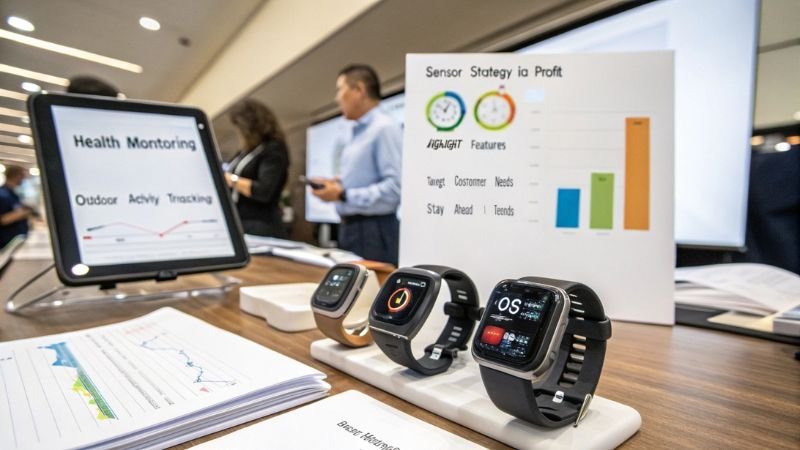
As a smartwatch seller, I’ve discovered that understanding and leveraging sensor technology is key to maximizing profits. But how exactly can sellers use smartwatch sensors to boost their bottom line?
By highlighting essential sensors, targeting specific customer needs, and staying ahead of trends, sellers can enhance product appeal and drive higher sales in the competitive smartwatch market.
Understanding the power of sensors can transform your sales strategy. Let’s dive into how you can make the most of these features to increase your profits.
How Can Sellers Effectively Market the Benefits of Smartwatch Sensors?
Marketing the benefits of smartwatch sensors isn’t just about listing features—it’s about showing how these sensors improve the user’s life. Effective marketing strategies can turn technical specifications into compelling reasons to buy.
To effectively market smartwatch sensors, sellers should translate technical features into real-life benefits, use engaging visuals, and connect with customers’ lifestyle needs.
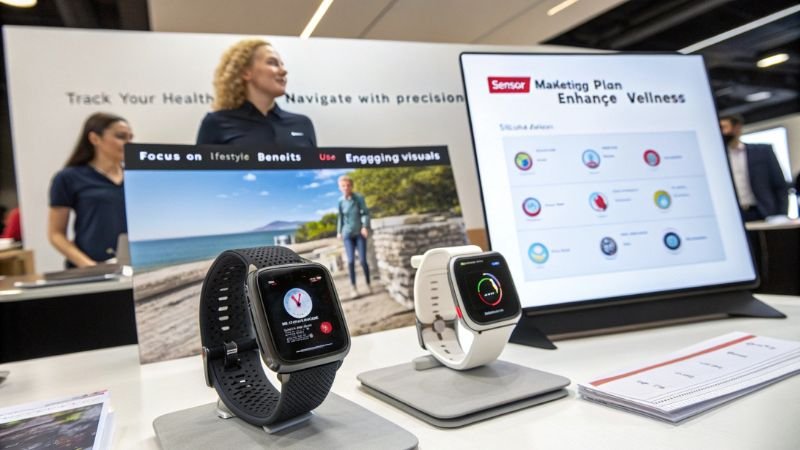
Translating Features into Benefits
When marketing smartwatch sensors, it’s crucial to focus on how these features solve problems or enhance the user experience. Here’s how I approach it:
1. Storytelling
I often use storytelling to make sensor benefits relatable. For example, instead of just saying "heart rate monitor," I share a story about how it helped someone optimize their workout routine1, leading to better fitness results.
2. Visual Demonstrations
Using videos or infographics to show sensors2 in action can make a big difference. Demonstrating how GPS tracks a run or how SpO2 sensors monitor oxygen levels during a hike helps customers visualize the benefits.
3. Highlighting Real-World Applications
I emphasize real-world applications of each sensor. For instance, showing how an accelerometer tracks steps and calories burnedHow do accelerometers and gyroscopes enhance fitness tracking? can attract fitness enthusiasts looking to stay active.
4. Customer Testimonials
Featuring testimonials from satisfied customers3 who have benefited from specific sensors adds credibility. Hearing from someone who improved their health using a smartwatch makes the features more trustworthy and appealing.
5. Educational Content
Creating blog posts or guides4 that explain the importance of each sensor helps educate customers. When they understand how a temperature sensor can monitor their wellness, they’re more likely to see its value.
| Marketing Strategy | Description |
|---|---|
| Storytelling | Share user experiences that highlight sensor benefits |
| Visual Demonstrations | Use videos and infographics to show sensors in action |
| Real-World Applications | Explain practical uses of each sensor |
| Customer Testimonials | Showcase positive reviews and success stories |
| Educational Content | Provide detailed guides and articles about sensor functionality |
Which Sensors Should Be Highlighted to Attract Fitness Enthusiasts?
Fitness enthusiasts are a lucrative market segment that values precise tracking and health monitoring. Highlighting the right sensors can make your smartwatch irresistible to this group.
Fitness enthusiasts look for sensors like heart rate monitors, accelerometers, gyroscopes, GPS, and SpO2 sensors, which enhance their workout efficiency and health tracking capabilities.
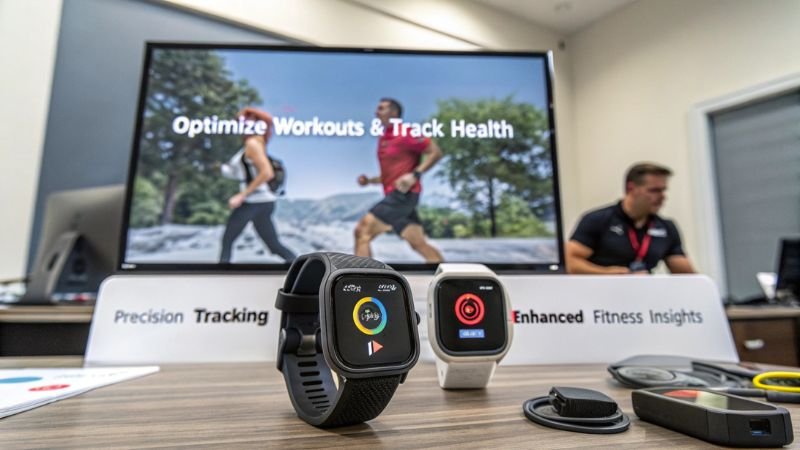
Catering to Fitness Enthusiasts
To attract fitness enthusiasts, it’s essential to focus on sensors that support their active lifestyles. Here are the key sensors to highlight:
Heart Rate Monitors
Heart rate sensors are fundamental for tracking workout intensity and optimizing training sessions. By monitoring heart rates5, users can ensure they’re exercising within their target zones, maximizing calorie burn, and avoiding overexertion.
Accelerometers and Gyroscopes
These sensors provide accurate movement tracking6, essential for counting steps, measuring distance, and analyzing motion patterns. They enable advanced features like activity recognition, which differentiates between walking, running, cycling, and other activities.
GPS
GPS sensors are a must-have for outdoor fitness activities7. They allow users to track their routes, measure distances, and analyze performance metrics. Highlighting GPS functionality appeals to runners, cyclists, hikers, and outdoor enthusiasts who rely on precise location data.
SpO2 Sensors
SpO2 sensors measure blood oxygen levels8, providing insights into respiratory health and overall wellness. For fitness enthusiasts, this data is invaluable for understanding how their bodies respond to different levels of exertion and recovery.
Additional Features
- Water Resistance: Essential for swimmers and those who engage in water-based activities.
- Battery Life: Long-lasting batteries ensure uninterrupted tracking during extended workouts or outdoor adventures.
| Sensor Type | Fitness Benefit |
|---|---|
| Heart Rate Monitor | Optimizes workout intensity and recovery |
| Accelerometer | Accurate step and movement tracking |
| Gyroscope | Enhances motion detection for varied activities |
| GPS | Precise route mapping and distance tracking |
| SpO2 Sensor | Monitors oxygen levels for respiratory health |
By emphasizing these sensors in your product descriptions and marketing materials, you can effectively attract fitness enthusiasts who are looking for reliable and feature-rich smartwatches9 to support their active lifestyles.
How Do Sensor Features Influence Customer Buying Decisions?
Sensor features play a pivotal role in customer buying decisions, as they directly impact the functionality and user experience of the smartwatch. Understanding how these features influence decisions can help sellers tailor their offerings to meet customer needs.
Advanced sensors like ECG and temperature monitors can sway buyers towards premium models, while essential sensors like heart rate monitors and accelerometers are critical for budget-friendly options.

The Psychology Behind Sensor Features
Perceived Value
Sensors add perceived value10 to smartwatches. Buyers are willing to pay more for devices that offer comprehensive health and fitness tracking. Features like ECG sensors provide a sense of security and advanced health monitoring, making them attractive to health-conscious consumers.
Functionality vs. Aesthetics11
While some customers prioritize functionality, others are drawn to the aesthetic appeal of a smartwatch. Sensors that enhance functionality, such as GPS and accelerometers, appeal to fitness enthusiasts, whereas design-oriented sensors like always-on displays attract fashion-conscious buyers.
Differentiation
Advanced sensors help differentiate your smartwatch from competitors. Offering unique sensor combinations12 can make your product stand out in a crowded market. For example, a smartwatch that combines ECG, SpO2, and temperature sensors provides a more comprehensive health monitoring solution than one with only basic sensors.
Trust and Credibility
Sensors that offer medical-grade data13, such as ECG and SpO2, build trust and credibility with customers. When buyers know that a smartwatch can provide accurate health data, they are more likely to trust the brand and make a purchase.
Long-Term Engagement
Sensors that track various aspects of health and fitness 14 encourage long-term use and engagement. Features like sleep tracking, stress monitoring, and activity recognition keep users invested in their smartwatch, leading to higher customer satisfaction and repeat purchases.
| Influence Factor | Impact on Buying Decision |
|---|---|
| Perceived Value | Higher price points justified by advanced sensor features |
| Functionality | Essential for fitness and health tracking needs |
| Aesthetics | Design features attract fashion-conscious buyers |
| Differentiation | Unique sensor combinations set products apart |
| Trust and Credibility | Medical-grade sensors build brand trust |
| Long-Term Engagement | Comprehensive tracking promotes continued use |
Understanding these influences allows sellers to prioritize sensor features that align with their target audience’s priorities, enhancing the overall appeal and increasing the likelihood of sales.
Why Should Sellers Emphasize Health Tracking in Their Product Descriptions?
Health tracking is a major selling point for smartwatches, as it aligns with the growing consumer focus on personal wellness and preventive healthcare. Emphasizing health tracking in product descriptions can significantly boost sales and attract a broader audience.
Health tracking features like heart rate monitoring, SpO2 sensors, and ECG functionality cater to a wide range of customers seeking to monitor and improve their health, making these features essential to highlight in product descriptions.
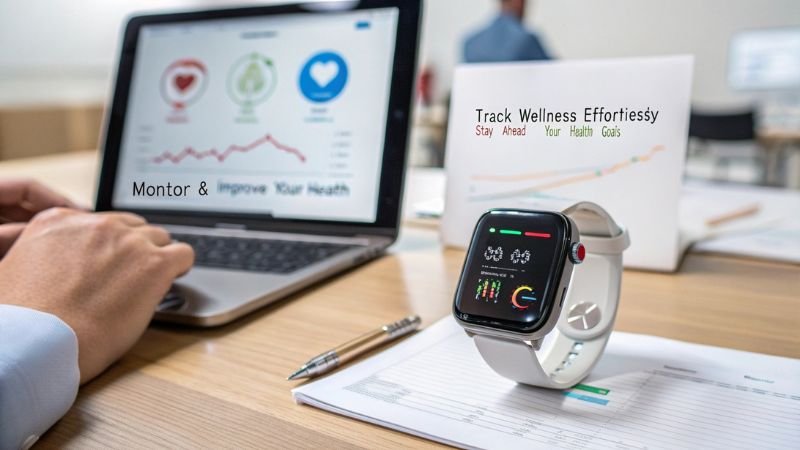
The Importance of Health Tracking
Comprehensive Health Insights
Health tracking15 sensors provide users with detailed insights into their physical well-being. By monitoring heart rate, blood oxygen levels, and electrical heart activity, smartwatches offer a holistic view of health that goes beyond basic fitness metrics.
Preventive Healthcare
Health tracking features enable users to detect potential health issues early. For example, irregular heart rhythms detected by ECG sensors can prompt users to seek medical advice, potentially preventing serious health problems16.
Wellness and Lifestyle Integration
Emphasizing health tracking integrates the smartwatch into the user’s daily wellness routine. Features like stress monitoring, sleep tracking17, and activity logging encourage users to maintain healthy habits and make informed lifestyle choices.
Appeal to a Broader Audience
By highlighting health tracking, sellers can appeal to a broader audience18, including individuals interested in fitness, those with specific health concerns, and tech enthusiasts who value advanced health monitoring technologies.
Enhancing User Engagement
Health tracking features promote continuous use of the smartwatch, as users regularly check their health data and track their progress19. This ongoing engagement can lead to higher customer satisfaction and loyalty.
| Health Tracking Feature | Customer Benefit |
|---|---|
| Heart Rate Monitoring | Optimizes workouts and tracks cardiovascular health |
| SpO2 Sensors | Monitors respiratory health and oxygen levels |
| ECG Functionality | Detects irregular heart rhythms and heart health |
| Sleep Tracking | Analyzes sleep quality and patterns |
| Stress Monitoring | Tracks stress levels and promotes relaxation |
By emphasizing these features in product descriptions, sellers can effectively communicate the value of their smartwatches, making them more attractive to health-conscious consumers.
How Do Sensors Help Differentiate Between Budget and Premium Smartwatch Models?
Sensors play a crucial role in distinguishing between budget and premium smartwatch models. By strategically incorporating and highlighting specific sensors, sellers can cater to different market segments and justify varying price points.
Budget smartwatches focus on essential sensors like heart rate monitors and accelerometers, while premium models offer advanced sensors such as ECG, SpO2, and GPS, appealing to discerning customers willing to invest more for enhanced functionality.
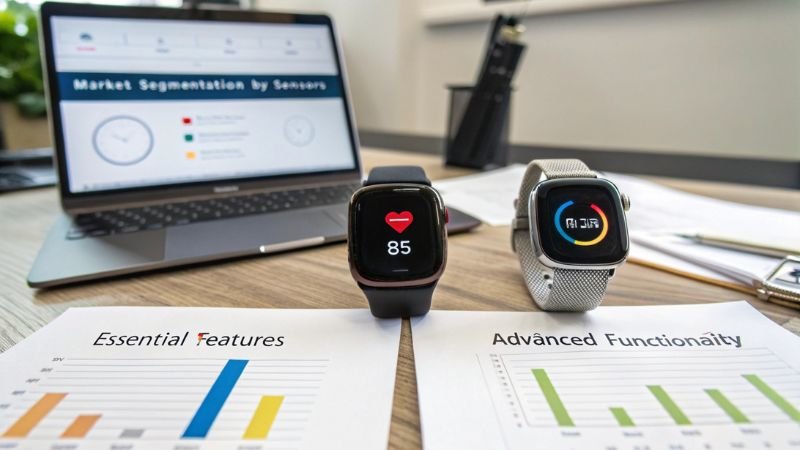
Differentiating Product Tiers with Sensors
Budget Smartwatches
Budget models typically include essential sensors that provide basic functionality at an affordable price20. These sensors cater to casual users who need reliable tracking without the extra bells and whistles.
- Heart Rate Monitors: Basic heart rate tracking is a staple in budget smartwatches, offering users essential fitness monitoring.
- Accelerometers: Essential for step counting and basic activity tracking, accelerometers ensure accurate movement data.
- Basic Notifications: Limited sensor capabilities for notifications and alerts keep costs down while still providing necessary functionality.
Premium Smartwatches
Premium models incorporate advanced sensors21 that offer enhanced features and superior performance, catering to tech-savvy and health-conscious customers willing to pay a higher price for added benefits.
- ECG Sensors: Provide detailed heart health insights, appealing to users who need medical-grade monitoring.
- SpO2 Sensors: Measure blood oxygen levels, offering advanced health tracking capabilities.
- GPS and GLONASS22: Enable precise location tracking and route mapping, essential for outdoor enthusiasts and athletes.
- Temperature Sensors23: Monitor skin or ambient temperature, contributing to holistic health tracking.
- Enhanced Gyroscopes: Support advanced motion tracking and gesture controls, enhancing user interaction and activity recognition.
Marketing and Positioning
When marketing, clearly differentiate budget and premium models based on sensor offerings. Highlight the essential features in budget models to emphasize value-for-money, while showcasing advanced sensors in premium models to justify higher prices and attract discerning customers.
| Model Type | Included Sensors | Target Audience |
|---|---|---|
| Budget | Heart Rate Monitor, Accelerometer, Basic Notifications | Casual users, budget-conscious buyers |
| Premium | ECG, SpO2, GPS, Temperature Sensor, Enhanced Gyroscope | Fitness enthusiasts, health-conscious, tech-savvy customers |
Pricing Strategy24
- Budget Models: Set competitive prices by focusing on cost-effective production and essential sensor integration. Highlight affordability and reliability in your marketing.
- Premium Models: Price higher based on the advanced sensor features and enhanced functionality. Emphasize the superior user experience and health benefits to justify the cost.
By clearly differentiating between budget and premium models through sensor offerings, sellers can effectively cater to various customer segments and maximize profits across different market tiers.
What Sensor Trends Should Sellers Monitor to Stay Competitive?
Staying ahead of sensor trends is crucial for maintaining competitiveness in the fast-evolving smartwatch market. Monitoring emerging technologies and consumer preferences ensures that your product offerings remain relevant and desirable.
Keeping an eye on trends like non-invasive glucose monitoring, advanced sleep tracking, environmental sensors, and AI-driven analytics can help sellers innovate and stay ahead of the competition.
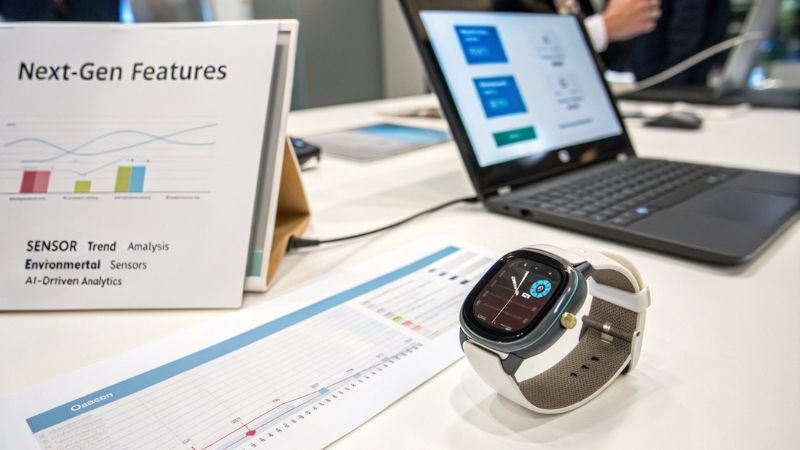
Emerging Sensor Innovations
Non-Invasive Glucose Monitoring
One of the most anticipated advancements in smartwatch technology is non-invasive glucose monitoring25. This feature allows users to track their blood sugar levels without the need for blood samples, making it a game-changer for individuals managing diabetes.
- Market Potential: High, as it caters to a significant population seeking convenient glucose monitoring solutions.
- Competitive Edge: Early adoption can position your smartwatch as a leader in health innovation, attracting a niche yet substantial customer base.
Advanced Sleep Tracking
Sleep tracking has evolved beyond basic metrics, with advanced sensors now capable of monitoring REM cycles, blood oxygen levels, and even stress indicators during sleep26.
- User Benefits: Provides comprehensive insights into sleep quality, helping users improve their sleep habits and overall health.
- Marketing Angle: Emphasize the importance of good sleep and how your smartwatch can help achieve it through detailed tracking.
Environmental Sensors
Environmental sensors that monitor air quality, UV exposure, and ambient temperature27 are becoming popular as consumers become more aware of their surroundings and health impacts.
- Target Audience: Outdoor enthusiasts, health-conscious individuals, and eco-friendly consumers.
- Product Differentiation: These sensors add unique value to your smartwatch, making it stand out in the market.
AI-Driven Analytics
Integrating AI with sensor data28 allows for personalized insights and predictive analytics, enhancing the user experience by providing actionable health and fitness recommendations.
- Enhanced Functionality: Offers tailored workout plans, health alerts, and lifestyle tips based on sensor data.
- Customer Appeal: Attracts tech-savvy users who appreciate intelligent, data-driven features.
Flexible and Modular Sensors
Developments in flexible and modular sensor technology29 allow for more comfortable and customizable smartwatch designs, catering to a wider range of user preferences.
- Design Innovation: Enables sleek, lightweight smartwatches without compromising on sensor capabilities.
- User Customization: Allows users to personalize their devices, enhancing satisfaction and brand loyalty.
| Emerging Trend | Sensor Feature | Potential Impact |
|---|---|---|
| Non-Invasive Glucose Monitoring | Glucose Sensors | High demand among diabetic and health-conscious users |
| Advanced Sleep Tracking | REM and Blood Oxygen Tracking | Comprehensive sleep insights and health improvements |
| Environmental Sensors | Air Quality, UV, Temperature | Enhanced outdoor activity tracking and health monitoring |
| AI-Driven Analytics | Personalized Health Insights | Improved user engagement and satisfaction |
| Flexible and Modular Sensors | Lightweight, Customizable Designs | Increased comfort and personalization options |
By monitoring these trends, sellers can innovate and introduce cutting-edge features that meet evolving customer needs, ensuring their smartwatches remain competitive and desirable.
How Can Sensor Knowledge Help Sellers Improve Product Selection and Inventory?
Deep knowledge of smartwatch sensors enables sellers to make informed decisions about product selection and inventory management, aligning offerings with market demands and customer preferences.
Understanding sensor capabilities and trends allows sellers to curate an inventory that meets diverse customer needs, optimize stock levels, and reduce excess inventory, thereby maximizing profitability.
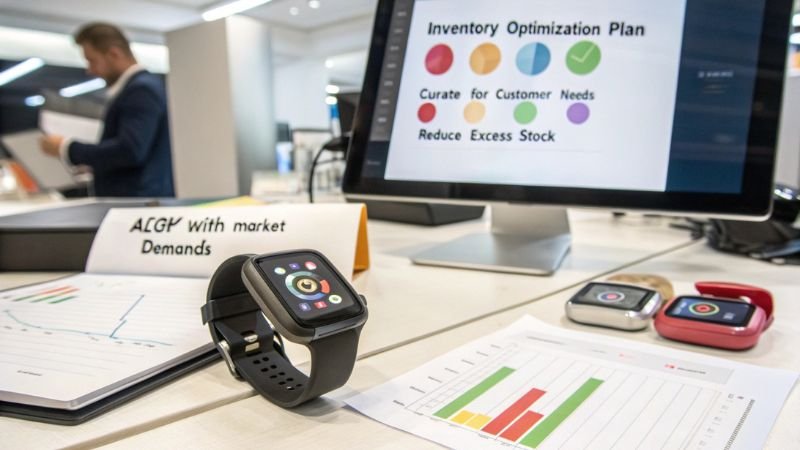
Strategic Inventory Management with Sensor Insights
Analyzing Customer Preferences
By understanding which sensors are most valued by different customer segments, sellers can tailor their inventory to meet specific needs. For example, if health-conscious buyers [prioritize ECG and SpO2 sensors]()30, ensuring a sufficient stock of models with these features can drive higher sales in that segment.
Forecasting Demand
Sensor trends help predict future demand31. If non-invasive glucose monitoring is on the rise, preparing your inventory to include smartwatches with this feature can position you ahead of competitors and meet anticipated market needs.
Reducing Overstock and Stockouts
Knowledge of sensor popularity helps in balancing stock levels. Avoid overstocking on models with less popular sensors and ensure adequate inventory of high-demand sensor-equipped smartwatches. This balance minimizes financial losses and maximizes sales opportunities.
Supplier Negotiations
Understanding the technical aspects and market value32 of different sensors strengthens your position in negotiations with manufacturers. You can negotiate better terms for high-demand sensors or secure exclusive features that set your products apart.
Diversifying Product Range
Sensor knowledge allows you to diversify your product33 offerings to cater to various niches. Offering a range of smartwatches with different sensor configurations attracts a broader audience, from fitness enthusiasts to tech-savvy health monitors.
Enhancing Marketing Strategies
With detailed sensor knowledge, you can create targeted marketing campaigns34 that highlight the most relevant features for each customer segment. This precision in marketing increases conversion rates and boosts overall sales.
| Inventory Strategy | Sensor Knowledge Application | Benefit |
|---|---|---|
| Customer Preference Analysis | Stock models with preferred sensors | Higher sales in targeted segments |
| Demand Forecasting | Anticipate trends and prepare inventory | Stay ahead of market needs and reduce delays |
| Overstock/Stockout Avoidance | Balance stock based on sensor popularity | Minimize financial losses and maximize sales |
| Supplier Negotiations | Leverage sensor demand insights | Better terms and exclusive features |
| Product Range Diversification | Offer varied sensor configurations | Attract a wider customer base |
| Targeted Marketing | Highlight relevant sensors for segments | Increase conversion rates and sales |
By leveraging sensor knowledge, sellers can refine their product selection, manage inventory more efficiently, and align their offerings with market demands, ultimately maximizing profits and ensuring long-term success in the competitive smartwatch market.
Conclusion
Smartwatch sensors are more than just technical features—they are essential tools that enhance user experience, drive sales, and differentiate products in a crowded market. By effectively marketing sensor benefits, highlighting key sensors for specific customer segments, understanding how sensor features influence buying decisions, and staying abreast of emerging sensor trends, sellers can maximize their profits and meet diverse customer needs. Emphasizing health tracking and using sensor knowledge to refine product selection and inventory further ensure that your smartwatch offerings remain competitive and desirable. In a rapidly evolving market, leveraging the power of sensors is the key to sustained success and profitability.
-
How do heart rate sensors improve fitness tracking in smartwatches? – Understand how heart rate sensors enhance workout efficiency and cardiovascular health, providing a practical example for storytelling and marketing. ↩
-
What are the best ways to visually market smartwatch features? – Explore techniques like videos and infographics to showcase smartwatch sensors in action, making the benefits more tangible and engaging for customers. ↩
-
Why are customer testimonials effective in marketing wearables? – Discover the importance of customer reviews and testimonials in building trust and showcasing the real-life impact of smartwatch features on users’ health and lifestyle. ↩
-
How can educational content improve smartwatch marketing? – Find out how creating blogs and guides that explain smartwatch features can educate customers and drive sales by emphasizing the value of advanced sensors. ↩
-
Why are heart rate monitors essential for fitness tracking? – Learn how heart rate monitors optimize workout intensity, helping users stay within target zones and avoid overexertion. ↩
-
How do accelerometers and gyroscopes improve fitness tracking? – Understand the role of motion sensors in providing accurate step counting, activity recognition, and motion pattern analysis for various workouts. ↩
-
How does GPS enhance outdoor fitness activities? – Discover how GPS sensors track routes, measure distances, and analyze performance metrics, appealing to runners, cyclists, and hikers. ↩
-
What is the role of SpO2 sensors in fitness wearables? – Explore how SpO2 sensors measure blood oxygen levels, helping users understand their exertion levels and recovery during workouts. ↩
-
What additional features do fitness-focused smartwatches need? – Find out why water resistance and long battery life are critical for fitness enthusiasts, especially for swimmers or those who engage in extended outdoor activities. ↩
-
How do smartwatch sensors increase perceived value? – Learn how advanced sensor features like ECG and SpO2 monitors justify higher price points by offering greater functionality and health insights. ↩
-
What is the role of functionality vs. aesthetics in smartwatch purchases? – Explore how functionality-focused sensors like GPS appeal to fitness enthusiasts, while design-oriented features attract fashion-conscious buyers. ↩
-
How do advanced sensors differentiate smartwatches in the market? – Understand how combining unique sensors, such as temperature and ECG monitors, helps smartwatches stand out in a competitive landscape. ↩
-
Why do medical-grade sensors build trust in wearables? – Discover how sensors providing accurate, medical-grade health data, such as ECG and SpO2, establish credibility and encourage purchases. ↩
-
What sensor features promote long-term smartwatch engagement? – Find out how comprehensive tracking features, including sleep and stress monitoring, encourage consistent use and improve customer satisfaction. ↩
-
Why is health tracking important in smartwatches? – Learn how health tracking features like heart rate and SpO2 monitoring provide users with critical health insights and align with the demand for preventive healthcare tools. ↩
-
How do ECG sensors in smartwatches detect health issues? – Understand how ECG functionality can identify irregular heart rhythms and encourage early medical intervention, making it a key feature for health-conscious buyers. ↩
-
What is the role of sleep and stress tracking in wearables? – Discover how features like sleep and stress monitoring integrate into users’ wellness routines, encouraging healthy habits and lifestyle choices. ↩
-
How does health tracking improve customer satisfaction? – Explore how ongoing engagement with health tracking features enhances user experience and loyalty by helping users achieve their health goals. ↩
-
What are the marketing benefits of emphasizing health tracking? – Find out why highlighting health features in product descriptions attracts a broader audience, including fitness enthusiasts and individuals with specific health concerns. ↩
-
How do heart rate monitors and accelerometers define budget models? – Understand how essential sensors like heart rate monitors and accelerometers provide the core functionality needed for budget smartwatches, making them affordable and accessible. ↩
-
What advanced sensors set premium smartwatches apart? – Explore the role of sensors like ECG, SpO2, GPS, and temperature monitoring in creating advanced features that justify higher price points in premium smartwatch models. ↩
-
How do GPS and GLONASS enhance premium smartwatch functionality? – Discover how advanced location tracking sensors cater to outdoor enthusiasts and athletes, providing precise route mapping and distance tracking. ↩
-
Why are temperature sensors valuable in premium wearables? – Learn how temperature sensors contribute to holistic health tracking, enhancing the appeal of premium smartwatches to health-conscious buyers. ↩
-
How should sellers price budget vs. premium smartwatches? – Find out how to set competitive pricing for budget models and higher pricing for premium models by emphasizing the value of their sensor features in marketing strategies. ↩
-
What is non-invasive glucose monitoring in wearables? – Learn about how this emerging technology allows smartwatches to monitor blood sugar levels without invasive procedures, revolutionizing health tracking for diabetic and health-conscious users. ↩
-
How do advanced sleep tracking sensors improve health monitoring? – Understand how sensors that track REM cycles, oxygen levels, and stress during sleep provide deeper insights into health and wellness. ↩
-
Why are environmental sensors important in smartwatches? – Discover the role of air quality, UV, and temperature sensors in enhancing smartwatch functionality for outdoor enthusiasts and health-aware customers. ↩
-
What are AI-driven analytics in wearables, and how do they work? – Explore how integrating AI with sensor data enables personalized health insights, predictive analytics, and tailored user experiences in smartwatches. ↩
-
How do flexible and modular sensors enhance smartwatch design? – Find out how these innovations improve user comfort, enable sleek designs, and allow for greater customization options in smartwatches. ↩
-
What sensors do health-conscious smartwatch buyers prioritize? – Discover which sensors, such as ECG and SpO2 monitors, are essential for health-focused buyers and how they influence purchasing decisions. ↩
-
How do sensor trends impact smartwatch inventory planning? – Learn how emerging sensor technologies, like non-invasive glucose monitoring, can guide inventory strategies to meet future market demands. ↩
-
Why is sensor knowledge critical for supplier negotiations? – Understand how detailed knowledge of sensor capabilities and market value can help sellers negotiate better terms and secure exclusive features with manufacturers. ↩
-
What are the benefits of offering diverse sensor configurations? – Find out how providing a variety of smartwatch models with different sensor capabilities can appeal to a broader audience and boost overall sales. ↩
-
How can sensor-based marketing improve sales? – Explore how highlighting specific sensor features in targeted campaigns can attract distinct customer segments and increase conversion rates. ↩


